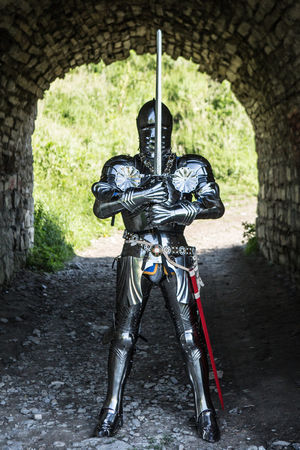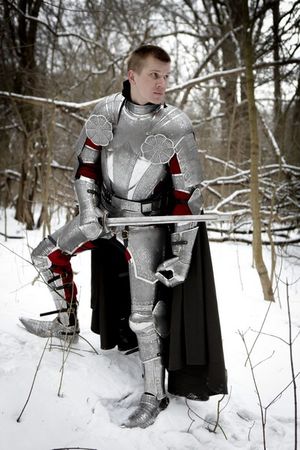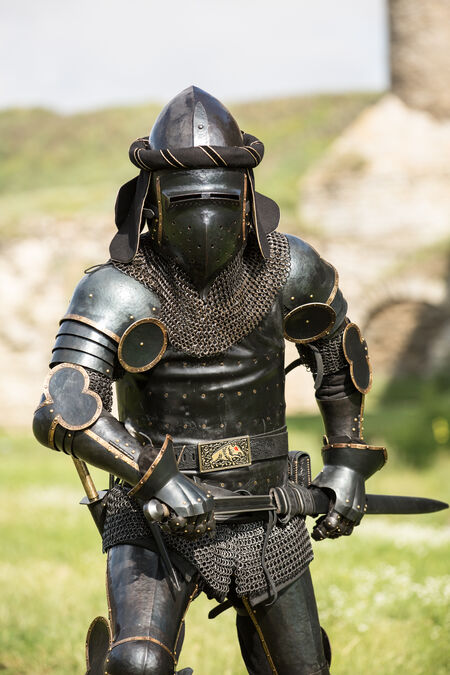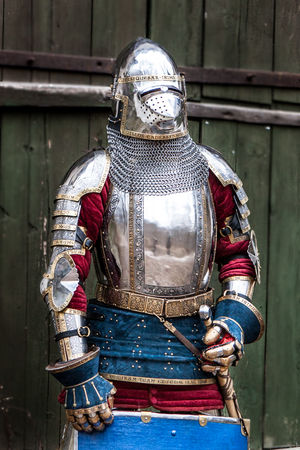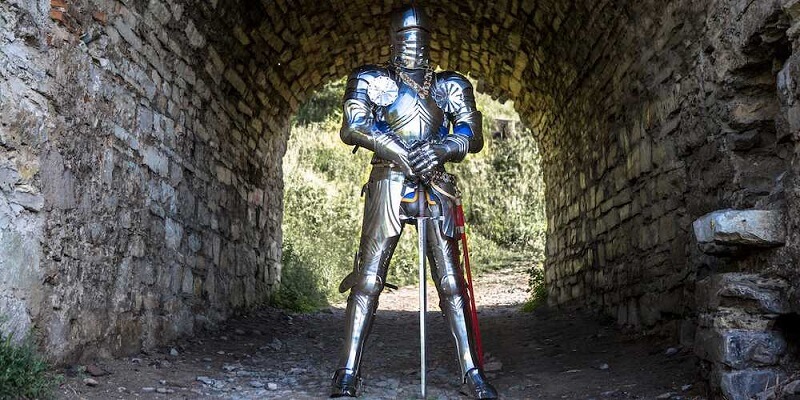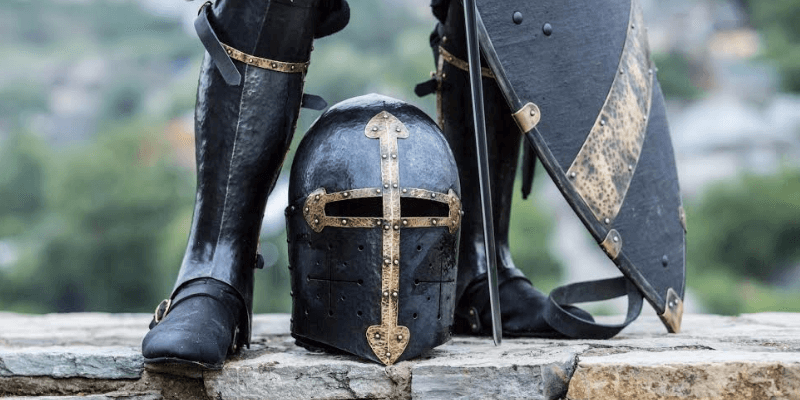News - The Cost of Plate Armor in Modern Money
The ongoing race between arms and armor in the Middle Ages led to the emergence and spread of many types of protection, such as mail-brigandine armor, mail-plate armor, and finally full plate armor.
Thinking of the Middle Ages as an era when warriors covered in steel plates became a mass phenomenon is, if nothing else, inaccurate. Full plate armor was widespread for a relatively short period of time, and even at the peak of popularity it was quite expensive. So, what preceded it?
For quite a long time — from the X to the XIII centuries — basic metal armor for those who could afford it consisted of long mail reaching the knees, with full length or partial sleeves (reaching the elbows), as well as a coif (a mail hood, separate or connected to the mail). In the latter case, the mail was called a “hauberk”. Front and back lower parts of the mail had cuts for more convenient movement, as well as providing more comfort when sitting in a saddle. Knights also wore a gambeson under the mail — you can read more about this type of protection in one of our previous posts. Often, to protect the legs they also wore mail hose.
In the XIII century, a combination of chain mail (also known as maille, or just mail) and a coat of plates (and, later, a brigandine), provided more protection than just mail alone. Both the coat of plates and brigandine are armor made of metal plates, riveted on cloth, quilted linen or another fabric — sometimes leather. There is no clear criteria to distinguish one from another, but it is generally assumed that a coat of plates consists of a smaller number of larger plates compared to a more sophisticated brigandine, and usually closes in the back. Early brigandine-mail protection consisted of a breastplate or a vest worn over the mail (hauberk). A statue of St. Maurice (1250) in Magdeburg is a good example of this combination.

St. Maurice statue, 1250. Magdeburg
In the XIV century the mail and coat of plates combination was still widely used, but a chest part of the protection became a larger curved breastplate which was much harder to penetrate with a spear, pointed sword and other weapons of the period. In parallel with this, some elements of plate armor begin to appear: first, a plackart and faulds covering the stomach of its wearer, and then a full cuirass. Due to its high cost, at the beginning of the XIV century cuirasses were available to few knights and nobles. In addition to that, we can see a spread of other types of steel plate protection, such as bracers, which protected from the elbow to the hand. From here, we can see the development of more extensive armor, such as full arm harnesses, greaves and kneecops.
In the second half of the XIV century the coat of plates became more complex in shape: more rounded, gradually approaching a narrow waist silhouette with a rounded single plate chestpiece.
The end of the XIV and the beginning of the XV centuries was a time characterized by a huge variety of combinations of armor: mail, coat of plates / brigandine and mail, brigandine and breastplate, full cuirass, accompanied or not by all kinds of bracers, arm harnesses, kneecops and greaves, as well as closed and open helmets with a variety of visors.
And it is the XV century that we can truly call the age of plate. Due to the development of metalworking and manufacturing technologies plate armor became way more accessible and, as a result, appeared in large numbers among knights and, to a lesser extent, infantry. Also, during this period, the fashion of covering armor with layers of fabric goes away, and the typical look for this period is shining (or not so much) “bare” exposed metal armor without a surcoat. The new shining look was often called a “white harness”.
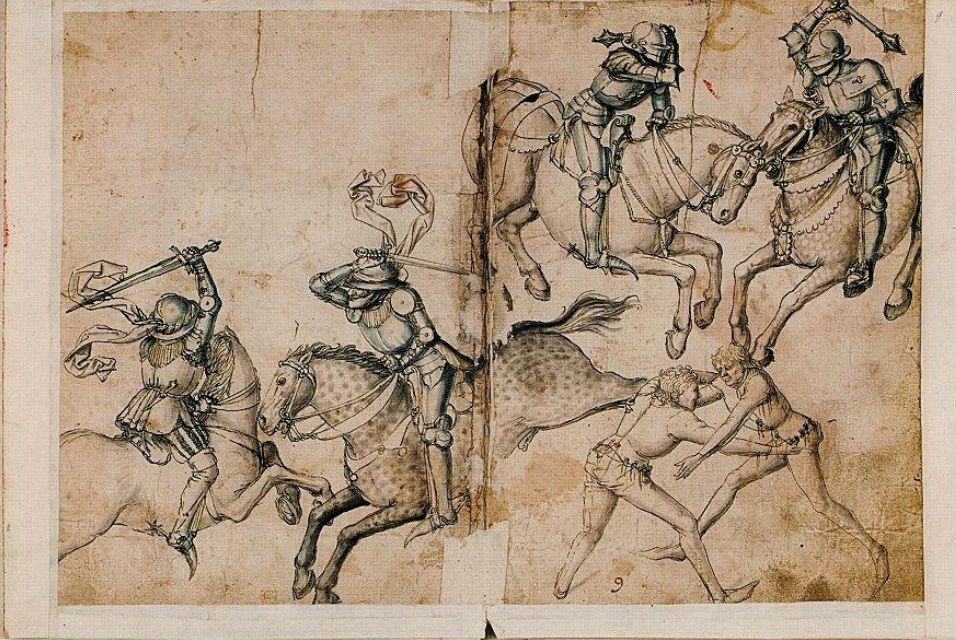
Late XV c. armor, Thun Sketchbook
Among our products there are a few examples of the armor typical for the XV century: a blackened “Wayward Knight” armor set with a coat of plates, that represents a transitional knight’s protection between the centuries, a knight armor kit “Paladin”, representing the full plate armor from the middle of the century, and a more sophisticated premium-looking and aristocratic “Gothic Armour Knight Kit”, inspired by a functional Gothic harness from the late XV century. We have already published a blog post dedicated to the Gothic armor. If you want to read more about this magnificent invention of the European armorers — make sure to check it out!
C. Blair, a famous British historian and armament specialist, called the time from 1410 to 1500 a “great period in the history of knightly protective armament,” since he believed that, although a high-quality armor was produced in later periods too, never again did they combine such excellence with an understanding of the material which they now mostly worked with in their products. Jewelry in the armor of this era played a minor role, and the armorers focused on the perfection of the form, so that people in this armor were justly called “steel sculptures”. Later, on the contrary, the decoration passed any measure.
By the middle of the 15th century, two main centers (and two different schools) were formed, producing full plate armor: the first one in Northern Italy, in Milan, and the second one in Northern Germany, in Augsburg. But, of course, there were many different local productions that basically copied popular samples of the above mentioned schools, sometimes modifying them to a greater or lesser extent.
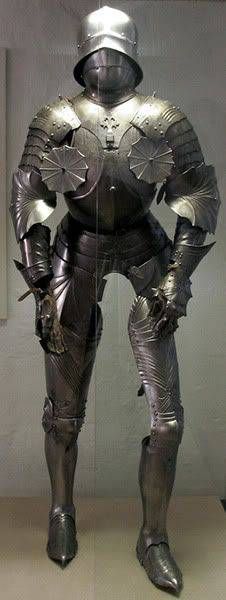
A typical gothic knight armor, 1480–1490. Ingoldstadt, Germany, Bavarian Military Museum
The famous British historian David Nicolle in his work “French Armies of the Hundred Years War” cites an excerpt from an essay by the unknown author of the book “Du Costume Militaire des Français en 1446”, who gives the following description of the equipment of those years, starting with a “lance” — basic cavalry unit of the time: “Firstly the said men-at-arms are commonly decked, when they go to war, in entire white harness. That is to say close cuirass, vambraces, large garde-braces, leg harness, gauntlets, sallet with visor and a small bevor that covers only the chin. Each is armed with a lance and a long light sword, a sharp dagger hanging on the left side of the saddle, and a mace. Each man must also be accompanied by a coutiller [squire] equipped with a sallet, harnois de jambes, haubergeon [hauberk], jacque [padded jack], brigandine or corset, armed with dagger, sword and a vouge [vogue] or demi-lance. Also a page or varlet with the same armour and one or two weapons. The archer wear leg armour, salets, heavy jacques lined with linen, or brigandines, bow in hand and quiver at side.”
As we can see, pages and squires, accompanying knights, had simpler protection typical in previous century: a mail hauberk and a brigandine, but with a more modern type of helmet. This is dictated both by tasks performed on the battlefield and by a trivial reason — an economic one. Not so many soldiers could afford a full plate armor.
So, how much did it cost? Let us turn to historical sources and try to compare the costs of the XV century plate armor with something from modernity for clarity.
Another quote from the above mentioned “French Armies of the Hundred Years War”: “The 125 to 250 livres tournois which one young nobleman required to fully equip himself represented eight to sixteen months’ wages for an ordinary man-at-arms, and clearly applied to the best possible gear. Even ordinary equipment remained expensive. Salets were valued at between 3 and 4 livres tournois, a jacque, corset or brigandine at 11 livres. A full set of such armour and weaponry cost around 40 livres while the cost for a complete lance was from 70 to 80 livres.”
Alan Williams in “The Knight and the Blast Furnace: A History of the Metallurgy of Amour in the Middle Ages and the Early Modern Period” provides some very interesting facts. For example, due to the change in technology at some point the production of mail has become more labor-intensive and less profitable than the production of plate armor: “When labour costs rose after the Black Death, then the price of mail rose accordingly. In an era of rising prices, it ceased to be an economically attractive way of making armour. Indeed, by the 15th century the cost of a mail shirt (4.59 gulden) at Iserlohn [Germany, North Rhine-Westphalia] was notably greater than the cost of plate armour (4.33 gulden).”
Also, in the book we find a table with horseman’s and foot-soldier’s armor prices:
| Date | Location | Foot-soldier’s armor price | Horseman’s armor price | Equivalent days’ wages |
|---|---|---|---|---|
| 1437 | Westphalia | £1 | 25 | |
| 1441 | England | £8.33 £5—£6 for imported Milanese armor |
100–166 | |
| 1468 | England (Milanese Armor) |
£7 | 100–166 |
Since many historians use the infantry's salary of the time as a reference to estimate the cost of armor in monthly wages, we suggest using a similar means of assessment. According to open sources, a US Army corporal earns about $30,000 a year, which gives us a monthly wage of $2,500. Now, this means that depending on the type, quality, place of manufacture, and finishing, a set of XV century plate armor would cost from $8,000 to $40,000 or more. At the same time, a simple set of armor for a regular foot soldier, especially if some obsolete pieces of equipment were used, could cost around $2,000 — but a good one would still be somewhere near $4,000 and more.
But.
When we talk about this price range, we still mean one of the most numerous parts of the armies — men-at-arms — ordinary soldiers, not the true elite, though their status allowed them to be referred to as “gentlemen”. By definition, those who fought in full plate armor were called 'men at arms', while a knight is a person granted an honorary title of knighthood by a political leader. And the price difference between the regular men-at-arms’ plate armor and knight’s plate armor is huge! It can be compared with a difference between a regular modern business suit and a modern exclusive designer limited edition bespoke business suit. Such armor was made to order by renowned armorers, and, as a rule, had decals and decorations, even if we are talking about combat, not ceremonial armor, and its cost converted by the above mentioned method was in the range of $100,000 to $250,000.
Also, let us not forget another important detail. A knight usually fights on a horseback. And a dead or seriously wounded horse is a huge problem, as the medieval armor ceases to play a significant role when you are thrown to the ground and surrounded by the enemy. A thin blade of a cheapest dagger in the joints of the armor caused the inglorious death of a myriad noble knights. The conclusion here is that your horse also needs reliable protection, otherwise your shiny armor can quickly change its owner!
And, of course, our ancestors began to create armor for horses “en masse” as soon as the technology and the economy allowed it. Here is another quote from David Nicolle: “... given the threat from English longbowmen, it is not surprising that the XIV century saw considerable development in horse armour. Early chamfrons covered only the front of the horse’s head, though some had and extended pol at the back. New forms which appeared later in the XIV century were larger, covering not only the back of the head but having a bulbous projection over the nose and pierced cups covering the eyes.”
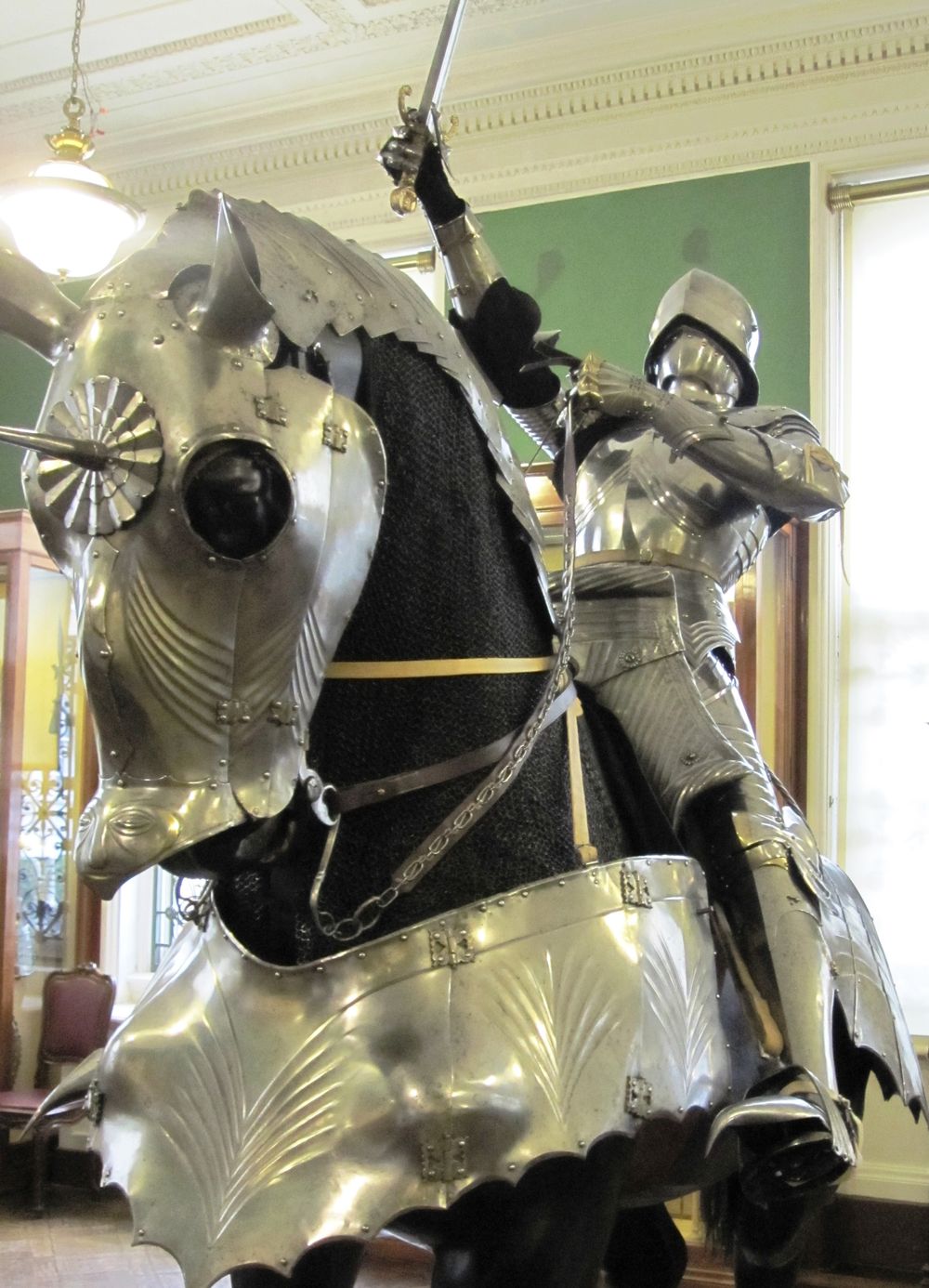
XV c. German Gothic Armor for Horse, Wallace Collection, London
Now, keeping in mind the above mentioned prices for the knightly armor, you can roughly imagine how much the horse’s armor would cost. Overall, expenses needed to equip a medieval European knight could go up to $500,000. Some researchers and medieval bloggers even say numbers go up to $3,500,000, but we could not find sources or historical examples of such an expensive armor. Nevertheless, we consider it possible. Perhaps the mentioned price was set for some very exclusive and richly decorated armor.
In addition, because of the spread and improvement of plate armor, in the XV century there was a gradual abandonment of shields as such. Shields turned into bucklers — small round fist shields, necessarily made of steel and with an umbon. They became a substitute for the knightly targe in foot combat, where they were used to both parry and strike with umbon or edge.
In the late XV — early XVI centuries, due to the gradual improvement of firearms two opposite processes occurred: if the armor of the cavalry was being increasingly strengthened and thickened, the infantry, on the contrary, becomes more and more “exposed”. In this period the famous “landsknechts” appeared — German mercenaries who served during the reign of Maximilian I (1486—1519) and his grandson Charles V (1519—1556). This infantry unit used only the cuirasses with tassets — at best. But since in Europe the cavalry was always a smaller part of the armies, we can observe a certain decrease in the proportion of full plate armor among military forces.
Thus, it is precisely the XV century that can be called the era of warriors protected by plates of steel.
Update: since the moment this blog post was published, we've enhanced the line of our armor sets significantly, adding lightweight spring steel protection. And wrote another detailed article about female armor: our take on women's knight kit

